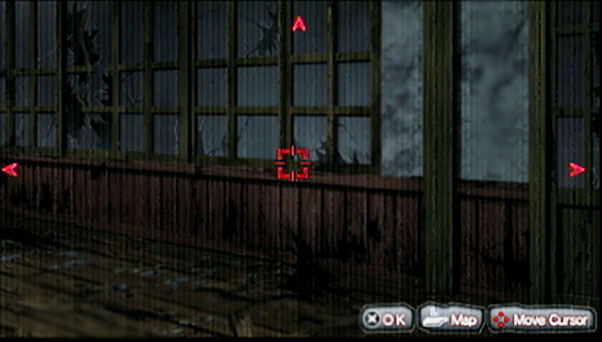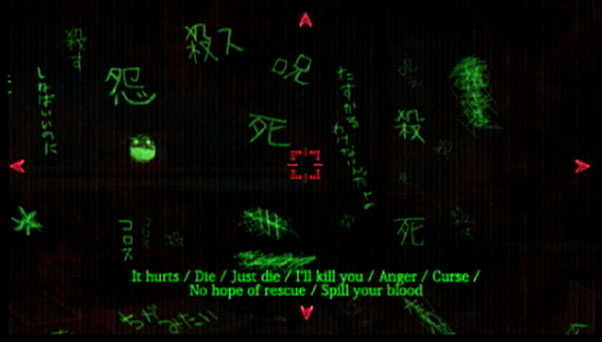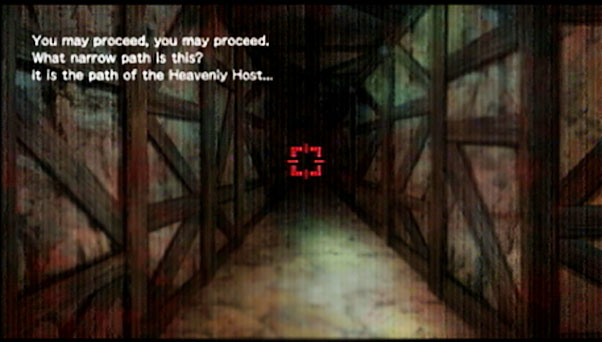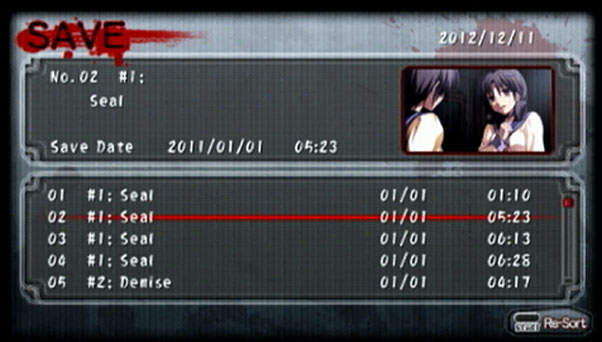 The first Corpse Party game chronicled the struggles of seven high school classmates,
The first Corpse Party game chronicled the struggles of seven high school classmates,
one little sister and one teacher who all got trapped in a cursed elementary school that shouldn't even exist, and were assaulted mercilessly therein by malevolent spirits. It was a game riddled with twists, turns and "wrong ends" that culminated in haunting, brutal death scenes, and its conclusion left many questions unanswered and more than a few loose threads untied (while at least one other was tied perhaps a bit too tightly)...
Corpse Party: Book of Shadows is a compilation of eight short stories set before, during and after these events, "fleshing" out the experience and further developing its characters and mythos alike.
Some chapters take place in an alternate timeline, where characters go into the events of Corpse Party with foreknowledge of the fates that are destined to befall them, granting them a rare opportunity to make different decisions and potentially avert their grisly demises.
Other chapters detail events leading up to Corpse Party, providing insight into the minds of some of its less prominent characters and revealing the influence they may have had in the grand scheme of things (or the influence it may have had on them).
And the final chapter, available only to those who have either played through the first Corpse Party or seen every wrong end in Corpse Party: Book of Shadows, details events from approximately two weeks after the first game's conclusion, delving deeper into the mystery as two characters frantically search for answers in a location even more cursed and uninviting than Heavenly Host Elementary itself

 Classic point-and-click gameplay enhances the series' rich atmosphere
Classic point-and-click gameplay enhances the series' rich atmosphereMore realistically-proportioned and immersive first-person environments with ending routes based solely on player decisions eliminate reliance on reflexes over strategy.
 "Darkening" system emphasizes the need to keep calm
"Darkening" system emphasizes the need to keep calmCharacters gradually become frightened and unstable, distorting the game's graphics and altering their decision-making abilities.
 Focus on side-characters and characters who received less "screen time" originally
Focus on side-characters and characters who received less "screen time" originallyThe already robust cast from the original is further humanized, adding to the game's immersion and preying on the player's sense of empathy.
 Full Japanese voice-acting and twice the binaural 3D audio effects
Full Japanese voice-acting and twice the binaural 3D audio effectsOriginal Japanese voices are kept intact for authenticity, and players can feel like they're part of the action by hearing speech, screams and spooky sounds coming from literally all around them when played with headphones.
 Text-skipping, fast-forward and save-anywhere features minimize repetition
Text-skipping, fast-forward and save-anywhere features minimize repetitionPlayers caught by "wrong ends" can easily redo whatever actions may have damned them by skipping and fast-forwarding through any scene in the game, as well as keeping ample saves on hand at crucial turning points (even if they're in the middle of conversations).
 Unlockable bonus features offer additional incentives to thorough players
Unlockable bonus features offer additional incentives to thorough playersCompleting chapters and viewing specific scenes unlocks art stills, music tracks, voice-actor interviews and more. Data from the first Corpse Party can be loaded for additional content, and viewing the game's true ending unlocks a special mode where custom conversations may be constructed from a selection of the game's voiced lines.
 Returning SoulsNaomi Nakashima
Returning SoulsNaomi NakashimaHaunted by feelings of deja vu, Naomi seems to know bits and pieces of the harrowing events that are destined to occur within Heavenly Host Elementary School. Determined to find some way of changing fate and preventing these tragedies from coming to pass, she must learn to suppress her own dark urges and control her inner demons, before it's too late.
Seiko ShinoharaFor longer than she can recall, Seiko has harbored feelings deeper than mere friendship for her bosom(ed) buddy Naomi, but has chosen to suppress them in order to support Naomi's wishes and dreams for the future. Once the nature of Heavenly Host becomes clear, however, Seiko realizes that her time on this earth may be limited, and she must decide whether to come clean or continue living a lie...
Mayu SuzumotoUnconsciously aware of the grisly end that fate has in store for her, Mayu embarks on a desperate search for her classmate and "rock," Morishige. Always struggling to stay one step ahead of certain death, Mayu's justified paranoia and careful planning help her reunite with old friends, and even make new ones. But the clock is ticking, and there are only so many places she can run before whoever (or whatever) is pursuing her finally catches up...
Yoshiki KishinumaThough impulsive by nature, Yoshiki can be surprisingly level-headed when the situation calls for it, easily serving as a voice of reason for those around him. His near-obsessive care and concern for Ayumi is what drives him onward, and he's willing to do whatever it takes to ensure her safety, even at the cost of his own. But in a place like Heavenly Host, is it really possible to protect another human being, or are one's efforts better spent on self-preservation?
Ayumi ShinozakiAyumi is perhaps more in danger than anyone else in Heavenly Host due to her natural receptiveness to spiritual energy. If she's not careful, she could become so deeply and completely possessed that her own soul would be lost forever -- and there's no telling what might take its place. Her only hope for salvation lies in the friendships she's forged with her classmates... but will that be enough?
Satoshi MochidaA doting brother, good friend, attentive student and all-around honorable individual, Satoshi is also a bit of a wuss (a fact which he himself readily admits). As a result of these personality traits, he's generally among the first people others look to as a leader, but the last person who should ever be given that role. And of course, when the time loop occurs, he's the only one who fully remembers all the events yet to come. Can he keep his friends out of harm's way, or will his meekness affect his credibility?
Yui ShishidoWhat makes this overzealous teacher's assistant tick? Corpse Party: Book of Shadows steps back a few years and looks at Yui in the past, during her senior year of high school. Back then, she wanted to be a teacher more than anything... but was she ready for it? Could she handle the responsibility? As an aspiring educator, where did she turn for help and support when she needed it? And perhaps most importantly... could she survive the deadly curse of Kisaragi High, or was her role destined to come to a premature end?
Naho SaenokiA famed paranormalist and published author who attends Paulownia High (when she can), Naho regards strangers and fans alike with a cold professionalism that really helps sell her to the public as a capable investigator. Once the cameras and microphones are off, however, she's like a playful cat on a sugar high -- a sight beheld only by her closest friends and acquaintances. The question is, which side of the coin represents Naho's true nature? Or is her true nature something altogether much darker...?
Sakutaro MorishigeIn the real world, Morishige is a loner. He's a stage actor for whom no one cheers, and a man with no real tact or social graces. A lifetime of this has made him an introvert, and as far as he's concerned, his only real friend in the world is Mayu, who regards him just as strongly as he regards her. But without Mayu around, Morishige is forced to find comfort wherever he can... even if it means obsessing over the dead while ignoring the living...
Yuuya KizamiKizami is a born psychopath. Even at a young age, death fascinated him while life held virtually no value. Sickened by the world's many social mores, Kizami seeks absolute honesty from those around him, and offers neither respect nor tolerance for anything less. When he was transported to Heavenly Host, he began to realize that the rules of society no longer applied, and thus decided to make this twisted space his own...
Yuka MochidaSatoshi's little sister, Yuka is not unlike a spoiled princess, always getting her way and depending on her big brother for absolutely everything. When separated from Satoshi and forced to act on her own for the first time in her life, however, Yuka has only two options: take charge and survive, or panic and perish under Heavenly Host's many deadly torments. Does she have what it takes, or is this destined to be her last stand?
The Recently DepartedNana Ogasawara(Last seen in Corpse Party Exchap 1)
A student from Musashigawa Girls' Middle School, previously seen taking the lead in finding a strange gentlemanly ghost's hat and glasses. Although she lacks self-confidence, Nana is an intelligent, talented and thoroughly competent individual who quickly befriends Mayu after learning that they're both active members in their respective schools' drama clubs. Despite being roughly the same age as Yuka, Nana acts significantly older and wiser, giving the impression that she's "mature beyond her years."
Tsukasa Mikuni(A new addition to the Corpse Party canon)
A classmate and love interest of Yui's from her high school days, Tsukasa was something of a lone wolf who spent much of his youth sitting on a bench at school and ruminating. He had a kind nature and a helpful disposition, however, which led to his chance encounter and burgeoning friendship with Yui. Though they never talked much in class, Tsukasa and Yui frequently sat together in the school courtyard and waxed poetic on the most inane of topics, thoroughly enjoying every minute of it.
Sayaka Ooue(Last seen in the Corpse Party Name Tag List)
Naho's best friend, Sayaka is an up-and-coming radio celebrity and voice actress who skips class at Paulownia High for work even more often than Naho does. Always bright and cheery, she's really the only one who can make Naho come out of her shell, and frequently finds herself playing master to her BFF's sudden feline persona. Sayaka trusts Naho implicitly, and would follow her into the depths of hell itself if asked...
Mitsuki Yamamoto(Last seen in Corpse Party Chapter 3)
One of the Byakudan High girls, regarded by her friends (usually in secret) as "Hellgirl Mitsuki." Though strong-willed and extremely demanding on the outside, Mitsuki is actually a very kind and conscientious person, always pushing to get done those tedious or unpleasant tasks that nobody really wants to do (but we all know we have to). As such, she's perfectly suited to her duties as student council clerk
Masato Fukuroi(Last seen in Corpse Party Chapter 3 and Exchap 4)
President of Byakudan High's student council, Fukuroi is a largely humorless person -- all business, no play. He's easy to anger, but never holds a grudge, and his target is usually well-deserving of his ire. In times of crCIA, Fukuroi is one of the best people you can have at your side. Of course, in a place like Heavenly Host, where logic and reason hold no meaning, a cool head can only get you so far..
Nari Amatoya(Last seen in Corpse Party Exchap 1)
A childhood friend of Nana's and classmate of Chihaya's. While Nana typically humors Chihaya's spoiled whinings, Nari sees that as enabling and instead chooses to exercise "tough love." This is indicative of her personality in general: a self-reliant, no-nonsense sort of person who believes it's better simply to do than to waste time worrying or bellyaching about life's little lemons. Whether or not this attitude can help keep her alive in an otherworldly hell, however, remains to be seen...
Chihaya Yamase(Last seen in Corpse Party Exchap 1)
The third member of the Musashigawa middle school trio, and easily the most helpless on her own. Without Nari or (preferably) Nana present, Chihaya really can't handle the world around her. Everything scares her, from thunder to slight movement, and she has a nasty habit of latching onto the shoulders of whoever's most convenient (much to Nari's chagrin) whenever she experiences any form of sudden fright. Considering the nature of Heavenly Host, this could be a virtually insurmountable problem.
Tohko Kirisaki(Last seen in Corpse Party Chapter 4)
An ordinary, fun-loving girl from Byakudan High. Has a major crush on Kizami, whom she believes to be an honest, honorable and generally even-tempered gentleman. He serves as something of an inspiration to her, giving her the courage to keep going even when things are looking grim. Should anything happen to change her image of Kizami, however...
Kai Shimada(Last seen in the Corpse Party Name Tag List)
Rude, boorish, violent and a renowned womanizer, Shimada is a street punk waiting to happen. Part of the Byakudan crowd, it's unclear how he actually wound up in his circle of friends, as nobody really seems to want him there. His impatience and general intolerance toward weak-willed men (and strong-willed women) often makes him a chore to be around, and he very clearly only ever thinks of himself. But the question is, will this powerful obstinacy make him harder to kill... or easier?
Emi Urabe(Last seen in the Corpse Party Name Tag List)
One of Tohko's friends from Byakudan High, Emi is a relatively well-regarded person thanks to her socially conscious behavior. She plays within the rules and says what people want to hear, and they like and respect her for it. In other words, she's pretty much the embodiment of the kind of person Kizami silently loathes. And within these horrid, blood-stained halls, perhaps social graces are more a detriment than they are a benefit...
Others: Ryosuke Katayama, Tomohiro Ohkawa, Kou Kibiki, Shougo Taguchi(Last seen in Corpse Party Chapter 5,
Exchap 4 and Exchap 7)
When Katayama of Byakudan High is gravely injured, how will his best friend Ohkawa react? How did occult journalist Kou Kibiki wind up in Heavenly Host to begin with? And what became of his cameraman, Mr. Taguchi, after the two got separated? Corpse Party: Book of Shadows features an ensemble cast of characters, some of whom players will recognize from the first game, while others are only now being given life (brief though it may be).

If any lines have been missed, a message log is available for review on the ∆ button menu, containing a lengthy transcript of everything that's been said since the chapter began or the game was loaded.
If you've seen an event play out once before and wish to skip over it, simply hold the R button to fast-forward, releasing it once you've reached the desired point in the storyline.
If you come to a decision, think carefully and choose wisely, as the things you say and do can have an immediate (and often quite drastic) effect on the plot, leading to unpleasant "wrong ends."
Beware, though, as some decisions are timed, and failing to make up your mind before time is up could prove fatal!
When you see the Search Mode text appear on the upper-right corner of the screen, that means you now have full control over your lead character. Move the red targeting reticule around the room with either the brown townog stick or directional buttons, and if it turns blue, that means it's positioned over something (or someone) that can be examined or interacted with.
Press the X button to examine or interact with objects, people or spirits during Search Mode. This includes talking, opening cabinet doors, using keys in locks and other basic actions, as well as picking up items and reading memos.
During Search Mode, you can usually (but not always) press the L button to bring up a map of your immediate surroundings. While this map is displayed, you may position the red box around your destination and press the X button to begin walking there (or running, if you hold the R button). If you decide not to change your location, you may press the L button again to close the map.
Note that due to holes in the floor, locked doors, etc., certain locations may be at least temporarily inaccessible or impassable. These are represented by gray squares on the map, and attempting to select such a location (or any location on the opposite side of a gray square) will have no effect.
Beware, too, as obstacles will often pop up between you and your destination, interrupting your trek with an event scene that may unexpectedly drop you back into Search Mode in a dangerous and/or undesirable spot.
As in the first Corpse Party, the students under your control are neither the first nor only victims to be whisked away into the hell that is Heavenly Host. During the course of your struggle, you may encounter the remains of those who came before you, most of whom still have their student ID name tags intact (albeit buried within rib cages or lodged beneath unnameable viscera).
At any time during play, you may open the ∆ button menu to check your Name Tag List for a comprehensive overview of all the unfortunate souls you've thus far identified.
Your character will encounter corpses (both fully intact and otherwise), crazed writings, malevolent spirits, booby traps, hordes of insects and innumerable other horrors within Corpse Party: Book of Shadows' many cursed grounds. Each time something truly frightening is experienced, your Darkening meter (visible on the ∆ button menu) will be raised. As it climbs closer and closer to 100%, distortions begin to appear on the screen, growing in intensity and increasing in number as the Darkening takes hold of your mind.Once your Darkening has passed certain thresholds, your characters may begin to lose their ability to reason, causing them to see and react to the environment differently than they otherwise would.If any character's Darkening should reach 100%, the game will conclude with either a haunting "wrong end" or a straight-up Game Over..
Source(WARNING:If you are weak hearted or do not like seeing gory stuff, do not click this loving link.)